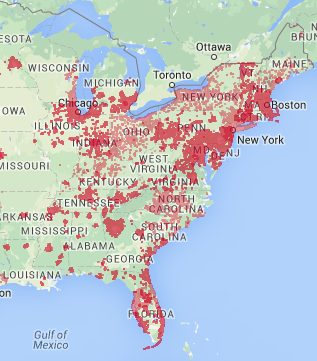Comcast could be the next cable operator to experiment with a new wireless service. Cablevision has pioneered the concept on the East Coast with its Freewheel service, offering unlimited voice, data and texting for $30 per month. The service is based on Wi-Fi hot spots, something Comcast has a lot more of than Cablevision.
Comcast has more than 8 million Wi-Fi hot spots, or seven times as many as Cablevision. The company uses some home Wi-Fi routers as public hot spots, and has faced legal action from disgruntled customers. But millions of Comcast hot spots are in public areas, and many are outdoors.
The Comcast hot spots are concentrated on the East and West Coasts, and the company’s Xfinity Internet customers can connect to them for free. In a number of areas the density is sufficient for mobile service on devices that support voice-over-Wi-Fi.
“If they were to offer a Wi-Fi calling sort of service it could be priced at $5/month and compete with Verizon,” said analyst Joe Madden of Mobile Experts.
Right now Comcast is partnered with Verizon Wireless, selling the carrier’s wireless service to its Xfinity Internet and cable customers. Comcast sold its wireless spectrum to Verizon three years ago.
After apparently turning its back on wireless, Comcast tried to grow its core cable business through a merger with rival Time Warner, but last month the Federal Communications Commission decided not to approve the deal. Some have speculated that Comcast will look for another acquisition target, and will take another look at wireless. T-Mobile US is seen as the most likely candidate. It’s possible that Comcast could bid for the carrier and try to combine T-Mobile US’ cellular network with its own Wi-Fi network.
Offering wireless service in partnership with a carrier is the model that Google is using for its Project Fi. Google has partnered with Sprint and T-Mobile US. The service works only with the Nexus 6 smartphone. Cablevision’s wireless service also works with only one smartphone, the Moto G.
The number of devices that can support voice-over-Wi-Fi is proliferating, but cable operators will need more than compatible phones and ubiquitous Wi-Fi if they want to succeed in wireless, according to veteran industry analyst Jeff Kagan. “They don’t understand the wireless marketplace and what it takes to be successful in it,” Kagan said. “As much of a desire as the cable TV industry has to be a powerful and successful player in wireless, I just don’t see them becoming one. Not at this time anyway.”
But the outlook for the traditional cable TV business is much less promising than the prospects for wireless. And Comcast’s millions of Wi-Fi hot spots represent an asset waiting to be monetized.
“No one knows where it’s going, and in fact if you ask the Comcast guys they’ll say that they don’t know where it’s going,” said Joe Madden of Mobile Experts. “But I think if they see an opportunity to monetize it, even if it’s $5 or $10 a month, I think they’ll start to offer something that looks like the Google Fi service or Republic Wireless.”
Follow me on Twitter.

